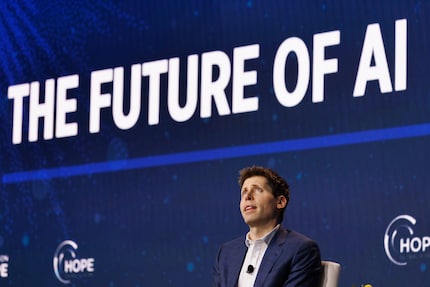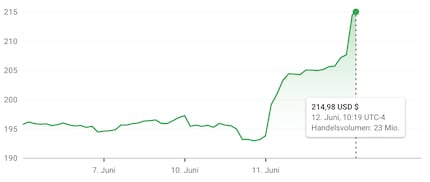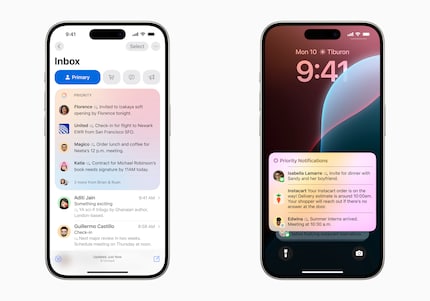
News + Trends
Apple launches its AI offensive
by Samuel Buchmann

Apple hopes to set itself apart from Microsoft and Google with personal AI in a balancing act between functionality, data protection and market power.
The artificial intelligence (AI) hype train is in full swing. Apple is the last tech giant to jump on board. At the start of the annual WWDC (Worldwide Developers Conference), software boss Craig Federighi presented Apple’s take on AI: Apple Intelligence.
Apple has set a different focus than Microsoft and Google, playing to strengths it has built up over the years – namely, total control over its ecosystem, and its customers’ deep-rooted trust. The ideas behind Apple Intelligence are interesting, and the architecture seems well thought out. But it lives or dies on everyday use.
Generative AI models feed off data. Companies such as OpenAI and Google treat their models like fattening pigs – the bigger, the better. ChatGPT and Gemini are devouring the entire internet, whether content creators want it or not. This method of action has advantages; the mass of information expands an AI’s content horizon. In other words, the AI knows a lot.
Fattening language models with internet fodder is both a blessing and a curse.
But fattening brings problems with it. ChatGPT and Gemini are wrong on a regular basis, for one, because its sources are often wrong. Fattening language models with internet fodder is both a blessing and a curse. In addition, training these models and then processing requests requires a lot of computing power.
Apple has opted for a different approach. Instead of a fattening pig, CEO Tim Cook wants to sell his customers an organic piglet. Apple Intelligence appears to be based on a smaller foundation of information. Its main feed is the user’s individual context, with the goal of providing personalised AI assistance – one that knows which flight your mother booked two months ago, because she mentioned it in a text message.

Apple is aware that, in some cases, this pool of data will prove insufficient. But a proprietary mega model is currently out of the question. Why? First, other companies are far ahead. Second, scouring the internet without obtaining copyrights probably isn’t an option for Apple; it wouldn’t match its ethical marketing. Instead, Apple outsources the dirty work. For features requiring vast general knowledge, it rents OpenAI’s fattening pig.
With its focus on data protection, Apple has created an image it wants to protect. At the same time, Apple has to make this version of Siri appealing to users – a version that has access to private and potentially highly sensitive information. Siri reads your e-mails. Siri has access to your credit card details. Siri knows your health data. It stands to reason that many will find this creepy.
Apple’s networked ecosystem allows for AI personalisation that its competitors can only dream of.
This AI offensive is calling in the enormous trust from Apple’s customers that the company has built up over the years. The devices and services are all linked to accounts. This networked ecosystem allows for AI personalisation that competitors can only dream of. The closest thing to it is Google. However, the search giant doesn’t enjoy the same level of trust when it comes to handling personal information – and usually penetrates fewer systems and areas of life than Apple.
The second home advantage is complete control over hardware and native apps. The AI model can be integrated at a system level. And not just on one device, but in a network spanning the iPhone, iPad and Mac. This gives Siri the potential for more features than other AI assistants. Non-native apps will also have access to parts of the AI via interfaces.
These possibilities harbour risks. Trust is fragile. Apple is walking a fine line between an AI that’s too limited and a potential company image scandal. It’s hard to imagine the outcry if personal data ended up with third parties without consent, or if the AI integration was abused by hackers. That’s why Apple offered a thorough precautionary explanation of the architecture behind Apple Intelligence during the WWDC.

Here’s Apple’s promise: requests and personal data either remain on the device or are encrypted before being sent to verified servers. There, Apple uses it exclusively for processing the current request, then deletes it. With this, the company wants to clearly differentiate itself from the collection-hungry competition.
This even applies in Apple’s collaboration with OpenAI. In fact, it comes across like a pact Apple would rather not enter into at all. OpenAI CEO Sam Altman is at the centre of the infighting. Whistle-blowers have reported on a culture of ruthlessness, and artists and media companies are suing the company for copyright infringement. That doesn’t fit in with Apple’s values. But the aim remains to offer customers OpenAI’s powerful language model.

What’s come about as a result of this tension? Apple has integrated ChatGPT into its systems, but clearly distances the chatbot from its own AI; you must explicitly grant permission for each request and the associated data to be forwarded to ChatGPT. According to Apple, these are anonymised before being sent to OpenAI; you don’t need a separate account. This, in turn, means OpenAI can’t create profiles of individual users.
Apple is doing a lot of things right – at least when it comes to protecting the privacy of its own users. With its implementation of AI, the company remains true to an old principle: it’s later to the party than others, but its implementation seems more sophisticated and prudent. This approach is coupled with superior communication, with Apple’s marketing communicating the innovation more vividly than the competition.
Apple is also positioning its hardware as a platform for third-party AI models.
AI could become highly profitable for Apple – even if the competition can do certain things better. Tim Cook has a two-track approach. First, premium features under Apple Intelligence could be monetised in the future. Second, Apple is also positioning its hardware as a platform for third-party AI models. Support for other models has already been announced.

If this plan works, Apple will remain the gatekeeper for a huge user base, even in the age of AI. The incentive for device upgrades is also increasing. Apple Intelligence needs the latest hardware. While the first version works with all Macs with M chips, you’ll need the iPhone 15 Pro to use it on your phone. Older, less expensive models won’t do the trick. And the more Apple integrates AI into its system, the greater the pressure to upgrade your hardware.
The generative functions presented for text and images are nothing new. Apple’s innovation is the seamless integration into its ecosystem. The key is keeping hurdles minimal. The average user doesn’t want to open a separate app to access a chatbot; they want to be presented with useful features in their moment of need, and said features must be presented clearly across apps and systems.

Apple Intelligence still has to prove just how useful it is in day-to-day life. After all, even the best architecture won’t matter if Siri can’t do what customers expect from it. The old version of Siri proved disappointing for precisely this reason. In addition, Apple Intelligence’s generative functions must also prove good and reliable enough. It’ll take a few months to judge if this is the case.
My fingerprint often changes so drastically that my MacBook doesn't recognise it anymore. The reason? If I'm not clinging to a monitor or camera, I'm probably clinging to a rockface by the tips of my fingers.
Interesting facts about products, behind-the-scenes looks at manufacturers and deep-dives on interesting people.
Show all